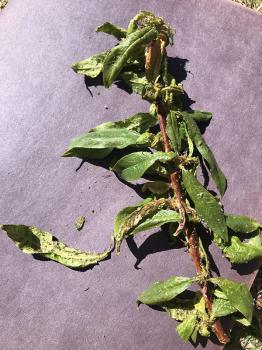April 20, 2019
Managing Aphid Outbreaks on Fruit Trees (and Other Plants)

Question:
What’s causing our peach tree leaves to wither and curl up completely and should we also be worried about our apricot trees nearby?
- Lorraine J., Los Lunas, NM
Answer:
Looking at the sample you brought in, the leaf curl on your peach tree branches is pretty extreme, and when I turned over and uncurled the leaves I found a ton of chubby green aphids hiding underneath. Some of the leaves, especially at the tips, are stunted and probably won’t fully expand after so much damage. Another aphid clue is the shiny, sticky coating on many of the leaves. The sticky shellac is called honeydew, which is a darling name for aphid excretion or – pardon my French – poo.

In my first New Mexico summer I was walking down Lomas Ave. in Albuquerque on the sidewalk in front of UNM-Hospital, just minding my own business, when I felt a lovely mist falling from the sky. It was brief, so I turned around to experience it again. I found that this fine mist was coming from a street tree that I now know to be a desert willow. I remember standing under the desert willow for a while, enjoying the evaporative cooling effect, amazed at how a desert plant could be so miraculous and kind. But that mist wasn’t water. It wasn’t until I took my first entomology class years later that I learned the truth about honeydew.
Aphids of various species can be expected each year on fruit trees and other landscape trees, shrubs, flowers, and vines. These guys suck fluids from leaves and excrete a sugary liquid that attracts ants and gets sticky and shiny as it coats the foliage.
Another effect of the aphid’s piercing-sucking mouthparts and eating habits is that the leaf can get deformed and start to curl up partially or entirely – especially on stone fruit trees like peaches, apricots, cherries, etc. Here’s where the task of controlling aphid populations gets tricky because they’re protected inside the curled up leaves.
For home gardeners, I recommend keeping an eye out for shiny leaves, chubby aphids, and curled, deformed leaves throughout the season on all landscape plants. When you find some, don’t worry about eradicating the entire population – that’s not even possible. Just use a hose sprayer to power wash the visible aphid clusters off the plants’ leaves, buds, and stems with water. Once washed off, aphids tend to be disoriented and slow at getting all the way back up to the tender, succulent new growth that they love.

Also keep an eye out for beneficial insects such as praying mantises, green lacewings, and ladybugs (more formally known as lady beetles). Ladybugs in the larval stage are weird, stout, black alligator-looking wigglers, often, but not always, with red markings. Insecticides might hurt the beneficial insect population before they’ve had a chance to work their magic. For photos of these beneficials, visit Desert Blooms.
Within an hour of examining Lorraine’s aphid-infested branch, I got a call from Otero County Extension Agent Sid Gordon to give me a heads up that two separate peach tree branch samples had been submitted to their County Extension Office in Alamogordo, both covered in aphids and one with lady beetle larvae, that very morning. So if you haven’t noticed signs of aphids yet, step outside, take another look, and keep vigilant.
I shared photos of the peach tree stem with NMSU Extension Entomology Specialist and NMDA State Entomologist Dr. Carol Sutherland. She pointed out the tiny white flaky bits as empty exoskeletons leftover after some aphids molted. “As the weather warms, the blackish aphids on stone fruits will likely fly away to alternate summer hosts. Green peach aphids will remain on peach trees all year long. As populations get large, winged aphids may be produced, but the tree will likely keep a residual aphid population. Natural enemies should have a field day on these things. Whether or not that will be good enough to control the pests to an acceptable level is undetermined, but possible.” For more aphid info, check out the NMSU Extension Guide Aphids and Their Relatives.
Luckily, this early in the season, foliar damage can be completely overcome by another flush of growth and even badly defoliated fruit trees can rebound in just a few weeks. Give the tree a leg-up by watering the entire root zone sufficiently to a depth of about 18-24 inches, depending on the size, and be sure to let the soil dry between irrigations.

Marisa Y. Thompson, PhD, is the Extension Horticulture Specialist, in the Department of Extension Plant Sciences at the New Mexico State University Los Lunas Agricultural Science Center, email: desertblooms@nmsu.edu, office: 505-865-7340, ext. 113.
Links:
For more gardening information, visit the NMSU Extension Horticulture page at Desert Blooms and the NMSU Horticulture Publications page.
Send gardening questions to Southwest Yard and Garden - Attn: Dr. Marisa Thompson at desertblooms@nmsu.edu, or at the Desert Blooms Facebook page.
Please copy your County Extension Agent and indicate your county of residence when you submit your question!